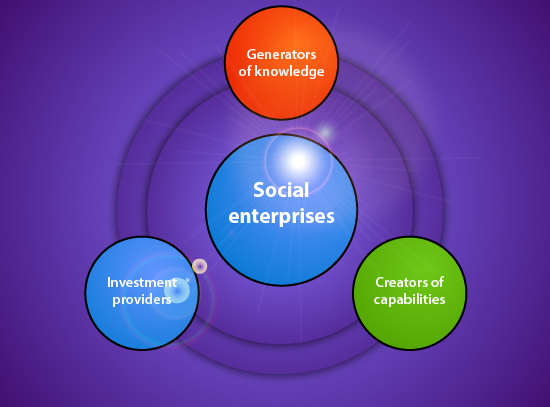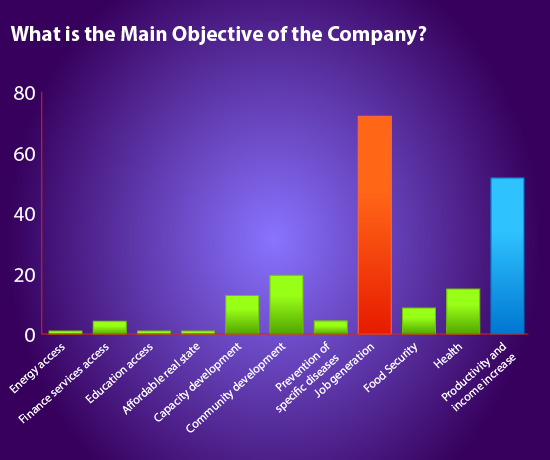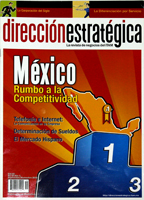
By: Caroline Auvinet
At the beginning of the 21st century, the number of people living on less than two dollars a day reached more than 4 billion. Society has become increasingly aware of the limitations of governments, civil society organizations and aid agencies in terms of providing health services, education, housing, and environmental and agricultural assistance. (Prahalad 2010). Facing these global challenges, social and environmental enterprises have emerged as an alternative solution for reducing poverty and inequality in the world. They are, in fact, “creating a new frontier, a quiet revolution.” (Bornstein, 2004)
In Mexico, many families and cooperatives have chosen to undertake income-generating activities to ensure a secure and stable employment. Some of these companies try to satisfy unmet needs in a community, employ people with low incomes or provide goods and services to the disadvantaged. In this way, they fulfill a social function that has not yet been resolved. Could these companies be called social enterprises?
The reality is that in Mexico the term “social enterprise” is not yet clearly understood. Social and environmental companies have existed for many years, but nowadays they have adopted a new role. According to Julián Costabile, director of the Social Investment Fund (FIS in Spanish), the principal goal of social enterprises is “to generate a social impact, to see profitability and business structure as a means rather than an ultimate end.” In other words, they are companies that cover the three basic criteria that distinguish them from other organizations: having social purposes, using business mechanisms to reach their objectives, and being independent. (Reficco, Gutiérrez and Trujillo, 2008).
The primary objective of a social enterprise is to seek a positive social or environmental impact and generate profits, and to contribute to maintaining or improving social conditions beyond the financial value created for those who have links with the companies. It is therefore important to understand the differences between a social enterprise and the social initiatives of business enterprises.
The goal of a social enterprise is to create social value and profits through marketing goods and services. In contrast, the objective of a social initiative of a business enterprise is to create economic value through the resolution of social problems, and to generate social value. (Reficco, Gutiérrez and Trujillo, 2008).
The innovations of social enterprises challenge the established players of an industry, offering simple and sufficient alternatives to a group of underserved consumers. These innovations change the status quo by providing adequate solutions to poorly addressed social problems. These innovations are called “catalytic innovations,” whose main goal is to create social change. (Christensen, Baumann, Ruggles and Sadtler, 2006). Christensen and his colleagues argue that through catalytic innovations, a subset of disruptive innovations, social enterprises can achieve success.
According to them, catalytic innovations:
(1) create systematic social change through scaling and replication; (2) satisfy a need that is either over-served (because the existing solution is more complex than many people require) or not served at all; (3) offer goods and services that are simpler and less costly than existing alternatives and whose performance may be perceived as somewhat inferior, but that users consider to be good enough; (4) obtain resources, such as donations, grants, volunteer manpower or intellectual capital in ways that are initially unattractive to established competitors, and; (5) are often ignored, disparaged, or even encouraged by existing players for whom the business model is unprofitable or otherwise unattractive and who therefore avoid or retreat from the market segment.
In Mexico, there are few businesses that meet these criteria. However, there are successful social enterprises that do not necessarily follow this model.
One of the main problems facing this movement is that people must understand and consider it as a real option for investment. Another is to create the necessary ecosystem that will allow these companies and investments to thrive.
According to New Ventures México, an ecosystem consists of a group of interrelated, but independent elements that interact in a dynamic way. Currently, the players that contribute to making the ecosystem more conducive to impact investment can be divided in the following manner:
Generators of knowledge. Schools that formally teach subjects related to social enterprises and impact investment.
Creators of capabilities. Organizations that advise social entrepreneurs, accelerate company growth, train, shape and link the players. These organizations include New Ventures México and Ashoka.
Investment providers. They facilitate investment, finance projects and provide funds to social enterprises. For example: Ignia and Adobe Capital.
Social enterprises. They are the core of the ecosystem.
The Impact Investment Ecosystem
In Mexico, various players are consolidating their efforts. Since the rules of the game have not yet been fully defined, their interactions are still deficient and poorly articulated. However, there are already cases of prosperous social enterprises, such as Échale a tu Casa, Aires del Campo and Chizca, to mention a few. These three examples come from different social sectors and have diverse strategies and organizational skills, but they concur in trying to have a social and environmental impact, in addition to generating profits.
The Survey
To learn more about the different business models of social and environmental enterprises, and understand how they innovate in their products, processes or services in Mexico, we conducted a survey to 200 companies during the XIII National Social Enterprises Fair, Expo FONAES 2011, and obtained a 25% response rate. These companies were supported by FONAES because they fulfilled the institution’s requirement of being located in priority areas, such as micro-regions, micro-watersheds, and urban polygons of poverty. Despite being companies that do not have large financial resources, some of these social enterprises have demonstrated a productive and organizational capacity, developing productive, commercial or service projects inherent in enterprises with a social character.
The survey was conducted by different means during the FONAES fair trade. It was conducted directly with the entrepreneurs who were actually present at the Expo. If the person in charge was not the entrepreneur or could not respond at that moment, they received a letter explaining the study and the reference of the website. Finally, companies with an email address were sent messages asking them to respond online.
The companies were selected so that all states of the republic were represented. Information on the following three main themes was obtained:
- Companies and their strategies
- The social impact they have or seek to have
- The success of the companies
The results provided interesting data, which we will discuss below.
On the Companies and their Strategies
The survey showed that the majority of the companies (58.7%) are family-owned, followed by 32.6% that are community-owned. The minority are private enterprises.
It also showed that 40.4% of the companies operate locally, 46.8% regionally, 21.3% nationally, and only 10.6% have activities abroad.
The activities of the surveyed enterprises include: 52.2% are focused on raw materials (forestry, agriculture, agribusiness, aquaculture, fisheries, minerals, etc.); 28.3% in manufacturing (power generation, management of resources such as water or waste, pharmaceutical, automobile, etc.); 41.3% in services (wholesale, retail, restaurants, hotels, tourism, energy, water, waste, financial services, transportation, distribution); and 4.3% in information (research and development, education, consulting, information technology, training).
1 According to the study “El ecosistema de inversión de impacto en América Latina”, by New Ventures with the support of Oportunidades para la mayoría del BID, Artemisia, Ashoka, Avina, Ayllu, The U.S. -Mexico Foundation, IPADE, NESsT, Nexii, Promotora Social México, RTI, SEAF y World Resources Institute. 2 FONAES is an agency of the Economy Secretariat of the federal government that finances business projects of the rural population, peasants, indigenous groups and urban social sector.3 Some of the survey questions were taken from the Call 2011 for New Ventures México.
As businesses, their main strategies for the future include:
- To grow through new sources of income, such as new products, customers and markets.
- To increase productivity by improving their production processes.
The majority considered that they create value for their customers by offering better quality as well as a variety of products. They think that what makes them different is having a better product.
Asked about the competition, 91.5% of the companies said they knew who their competitors were. They also said they had cheaper products or services that were better quality, more convenient and more complex than the competition. This leads us to think that what is lacking is a defined strategy to differentiate themselves as a company and to cover a specific market.
Asked if they had duplicated their business model, 79.5% said they had not duplicated it, but of these, 76.9% said they would duplicate it if it were possible. Of the 20.5% that duplicated the business model, only 44.4% obtained the same results. /p>
On the Social Impact
According to the survey, 61.4% of the companies covered an already addressed need, and 38.6% an unmet need. Upon analyzing the latter, it was noted that the unmet needs were local needs that were already covered in other localities or regions.
Although 72.3% of the companies stated that their main objective was to generate profits and to create a social or environmental impact, when asked about their main social objective, 71.7% of those surveyed said it was to generate employment. Taking into account that the companies surveyed have an average of 10 fulltime employees, and are family-owned, we conclude that in general the companies interviewed are forms of self-employment.
Table 2 What is the Main Objective of the Company?
On Success Factors
In analyzing the companies’ key success indicators, we obtained the following results:
Of the companies surveyed, 89.4% made profits, but only 48.9% have managed to grow since their founding. The number of employees remained the same in 51.1% of the companies, while 72.3% have increased the number of products offered.
On average, the companies interviewed had been in business for eight years, which suggests that they are established companies.
When asked how they had used the resources received from FONAES, 75.7% replied: to strengthen the company (purchasing equipment and machinery). They also took training courses to learn how to develop a business plan, an illustrated manual, a web page, and received advice on reinforcement and competition.
Conclusions
Several conclusions can be drawn from the data obtained in the survey.
- As businesses, the majority of the social enterprises interviewed lack a clear differentiation in relation to the competition, which suggests the absence of strategic planning for the future.
- The majority of the companies have little social impact and the sources of work that they generate are mainly for self-employment.
- The success factors that were analyzed show that, in general, the companies are growing.
These businesses receive advice on how to consolidate their efforts as social enterprises. Since they are at the initial stage of the process, recommendations on how to clarify their strategies would be useful.
If we consider the key points catalytic innovations share, we did not found companies that comply with the five qualities simultaneously. The method devised by Christensen, Baumann, Ruggles and Sadtler is a good tool when developing a new social enterprise or when investment funds in search of new opportunities identify possible disorders within an industry. However, it is difficult to apply the theory of catalytic innovation as a strategy once a social enterprise has found its way and has adopted another business model.
The main difficulties facing social enterprises are: to generate a social impact that is systematically verifiable; to differentiate themselves from their competitors; and to become independent of government or NGO support. Therefore, the main focus of their work should lie in the measurement of its performance, the innovation within their business model and their independence.
We are not criticizing the support social enterprises receive. When they first start up, the majority obtain various kinds of support. But social enterprises should aspire to become independent, and the sooner they do, the better.
As we said at the beginning, a social enterprise must generate profits while having a positive social or environmental impact. Among the companies surveyed, the social impact of many of them is questionable.
Social enterprises must understand that their goal is to produce a social or environmental impact while generating profits. Self-employment can be an attractive part of the undertaking, but the social impact must seek social change. For this reason, the measurement of the impact is a key factor for the development, credibility and survival of these companies, just like it is in any business. Without a correct measure of its impact, they will have difficulty attracting investors.
Finally, speaking of business strategies, needless to say it is difficult for any company to survive, whether it be a social enterprise or not. If it does not clearly differentiate itself from its competitors with an innovative business model, it will have trouble surviving when the financial support ends and when it tries to enter new markets in which its product faces competition that did not exist in its original locality.
In summary, companies should follow three strategies to attract private investors or to ensure sustainable growth:
4The Global Impact Investing Network (GIIN) developed the Impact Reporting and Investment Standards (IRIS) to measure the social and environmental performance of enterprises. For more information, visit the web site http://iris.thegiin.org/- Clearly identify its social impact and adopt it as the main pillar of the company. Businesses should choose at most five variables to measure its impacts. Here the most important thing is to measure them continuously with internationally recognized standards to prove that they have been achieved.
- Define the company’s future goals, and based on them, elaborate a strategic plan. Various strategic tools, like the analysis by Porter and the FODA, can be useful in determining to whom the product is directed and to differentiate it from the competition.
- Become independent as a business. Government programs, and those of NGOs and private companies, are a great help when starting a social enterprise or when trying to strengthen it, but they should not be depended on.?
References
- Bornstein, D. (2004) Cómo cambiar al mundo: Emprendedores sociales y el poder de las nuevas Ideas.
- Christensen, C. Baumann, H. Ruggles, R. Sadtler, T. (2006, diciembre) Disruptive Innovation for Social Change. Harvard Business Review.
- New Ventures, Convocatoria 2011 New Ventures México, .
- New Ventures, “El Ecosistema de Inversión de Impacto en América Latina” realizado por New Ventures con el apoyo de Oportunidades para la mayoría del BID, Artemisia, Ashoka, Avina, Ayllu, The U.S.-Mexico Foundation, IPADE, NESsT, Nexii, Promotora Social México, RTI, SEAF y World Resources Institute.
- Prahalad, C.K. (2010). The fortune at the bottom of the piramid: Eradicating poverty through profits. 5a. ed. New Jersey: Wartton School Publishing.
- Reficco, E. Gutiérrez, R. Trujillo, D. (2008, octubre-diciembre). Empresas sociales: ¿una especie en busca de reconocimiento? Revista de Administración-RAUSP, 41, .4: 404-418.
Web sites:



































One Comment
Excelente artículo, un claro panorama de la actividad de una empresa social, que ciertamente no es lo mismo que una empresas con iniciativas sociales. Si conocen de algún curso de especialización en gestión de empresas sociales compartirlo por favor. Saludos.